Loading... ## 前言 之前一篇文章介绍了基本的统一异常处理思路: [Spring MVC/Boot 统一异常处理最佳实践](http://www.zhaojun.im/springboot-exception/). 上篇文章也有许多人提出了一些问题: * 如何区分 Ajax 请求和普通页面请求, 以分别返回 JSON 错误信息和错误页面. * 如何结合 HTTP 状态码进行统一异常处理. 今天这篇文章就主要来讲讲这些, 以及其他的一些拓展点. <!-- more --> ## 区分请求方式 其实 Spring Boot 本身是内置了一个异常处理机制的, 会判断请求头的参数来区分要返回 JSON 数据还是错误页面. 源码为: `org.springframework.boot.autoconfigure.web.servlet.error.BasicErrorController`, 他会处理 `/error` 请求. 核心处理代码如下: ```java @RequestMapping( produces = {"text/html"} ) // 如果请求头是 text/html, 则找到错误页面, 并返回 public ModelAndView errorHtml(HttpServletRequest request, HttpServletResponse response) { // 1. 获取 HTTP 错误状态码 HttpStatus status = this.getStatus(request); // 2. 调用 getErrorAttributes 获取响应的 map 结果集. Map<String, Object> model = Collections.unmodifiableMap(this.getErrorAttributes(request, this.isIncludeStackTrace(request, MediaType.TEXT_HTML))); // 3. 设置响应头的状态码 response.setStatus(status.value()); // 4. 获取错误页面的路径 ModelAndView modelAndView = this.resolveErrorView(request, response, status, model); return modelAndView != null ? modelAndView : new ModelAndView("error", model); } @RequestMapping @ResponseBody public ResponseEntity<Map<String, Object>> error(HttpServletRequest request) { // 调用 getErrorAttributes 获取响应的 map 结果集. Map<String, Object> body = this.getErrorAttributes(request, this.isIncludeStackTrace(request, MediaType.ALL)); // 获取 HTTP 错误状态码 HttpStatus status = this.getStatus(request); // 返回给页面 JSON 信息. return new ResponseEntity(body, status); } ``` > 这两个方法的共同点是: 他们都调用了 this.getErrorAttributes(...) 方法来获取响应信息. 然后来看看他默认情况下对于 AJAX 请求和 HTML 请求, 分别的返回结果是怎样的:  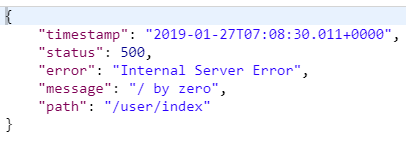 对于返回错误页面, 其中还调用了一个非常重要的方法: `this.resolveErrorView(...)` 方法, 源码我就不带大家看了, 他的作用就是根据 HTTP 状态码来去找错误页面, 如 500 错误会去找 `/error/500.html`, 403 错误回去找 `/error/403.html`, 如果找不到则再找 `/error/4xx.html` 或 `/error/5xx.html` 页面. 还找不到的话, 则会去找 `/error.html` 页面, 如果都没有配置, 则会使用 Spring Boot 默认的页面. 即:  看到这里, 应该就清楚了, 我们主要需要做四件事: 1. 发送异常后, 重定向到 `BasicErrorController` 来处理 (既然Spring Boot 都已经写好了区分请求的功能, 我们就不必要再写这些判断代码了) 2. 自定义 HTTP 错误状态码 3. 他返回的信息格式可能不是我们想要的, 所以必须要改造 `getErrorAttributes(...)` 方法, 以自定义我们向页面返回的数据. (自定义错误信息) 4. 创建我们自己的 `/error/4xx.html` 或 `/error/5xx.html` 等页面, (自定义错误页面) ### BasicErrorController 第一点很简单, `BasicErrorController` 他处理 `/error` 请求, 我们只需要将页面重定向到 `/error` 即可, 在 ControllerAdvice 中是这样的: ```java @ControllerAdvice public class WebExceptionHandler { @ExceptionHandler public String methodArgumentNotValid(BindException e) { // do something return "/error"; } } ``` ### 自定义 HTTP 错误状态码 我们来看下 `this.getStatus(request);` 的源码, 看他原来时如何获取错误状态码的: ```java protected HttpStatus getStatus(HttpServletRequest request) { Integer statusCode = (Integer)request.getAttribute("javax.servlet.error.status_code"); if (statusCode == null) { return HttpStatus.INTERNAL_SERVER_ERROR; } else { try { return HttpStatus.valueOf(statusCode); } catch (Exception var4) { return HttpStatus.INTERNAL_SERVER_ERROR; } } } ``` 简单来说就是从 request 域中获取 `javax.servlet.error.status_code` 的值, 如果为 null 或不合理的值, 都返回 500. 既然如何在第一步, 重定向到 `/error` 之前将其配置到 request 域中即可, 如: ```java @ControllerAdvice public class WebExceptionHandler { @ExceptionHandler public String methodArgumentNotValid(BindException e, HttpServletRequest request) { request.setAttribute("javax.servlet.error.status_code", 400); // do something return "forward:/error"; } } ``` ### 自定义错误信息 也就是 getErrorAttributes 方法, 默认的代码是这样的: ```java public Map<String, Object> getErrorAttributes(WebRequest webRequest, boolean includeStackTrace) { Map<String, Object> errorAttributes = new LinkedHashMap(); errorAttributes.put("timestamp", new Date()); this.addStatus(errorAttributes, webRequest); this.addErrorDetails(errorAttributes, webRequest, includeStackTrace); this.addPath(errorAttributes, webRequest); return errorAttributes; } ``` 他获取了时间戳, 错误状态码, 错误信息, 错误路径等信息, 和我们之前看到默认的返回内容是一致的: ```json { "timestamp": "2019-01-27T07:08:30.011+0000", "status": 500, "error": "Internal Server Error", "message": "/ by zero", "path": "/user/index" } ``` 同样的思路, 我们将错误信息也放到 request 域中, 然后在 getErrorAttributes 中从 request 域中获取: ```java @ControllerAdvice public class WebExceptionHandler { @ExceptionHandler public String methodArgumentNotValid(BindException e, HttpServletRequest request) { request.setAttribute("javax.servlet.error.status_code", 400); request.setAttribute("code", 1); request.setAttribute("message", "参数校验失败, xxx"); // do something return "forward:/error"; } } ``` 再继承 `DefaultErrorAttributes` 类, 重写 `getErrorAttributes` 方法: ```java //@Component public class MyDefaultErrorAttributes extends DefaultErrorAttributes { @Override //重写 getErrorAttributes方法-添加自己的项目数据 public Map<String, Object> getErrorAttributes(WebRequest webRequest, boolean includeStackTrace) { Map<String, Object> map = new HashMap<>(); // 从 request 域中获取 code Object code = webRequest.getAttribute("code", RequestAttributes.SCOPE_REQUEST); // 从 request 域中获取 message Object message = webRequest.getAttribute("message", RequestAttributes.SCOPE_REQUEST); map.put("code", code); map.put("message", message); return map; } } ``` ### 自定义错误页面 我们遵循 SpringBoot 的规则, 在 `/error/` 下建立 `400.html`, `500.html` 等页面细粒度的错误, 并配置一个 `/error.html` 用来处理细粒度未处理到的其他错误. **/error/400.html** ```html <!DOCTYPE html> <html lang="en" xmlns:th="http://www.thymeleaf.org"> <head> <meta charset="UTF-8"> <title>400</title> </head> <body> <h1>400</h1> <h1 th:text="${code}"></h1> <h1 th:text="${message}"></h1> </body> </html> ``` **/error/500.html** ```html <!DOCTYPE html> <html lang="en" xmlns:th="http://www.thymeleaf.org"> <head> <meta charset="UTF-8"> <title>500</title> </head> <body> <h1>500</h1> <h1 th:text="${code}"></h1> <h1 th:text="${message}"></h1> </body> </html> ``` **/error.html** ```html <!DOCTYPE html> <html lang="en" xmlns:th="http://www.thymeleaf.org"> <head> <meta charset="UTF-8"> <title>系统出现了错误</title> </head> <body> <h1>ERROR PAGE</h1> <h1 th:text="${code}"></h1> <h1 th:text="${message}"></h1> </body> </html> ``` ## 测试效果 到此位置, 大功告成, 然后来创造一个异常来测试一下效果: 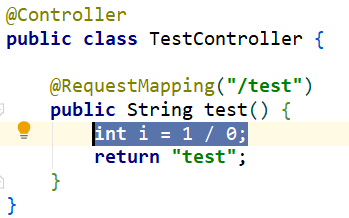 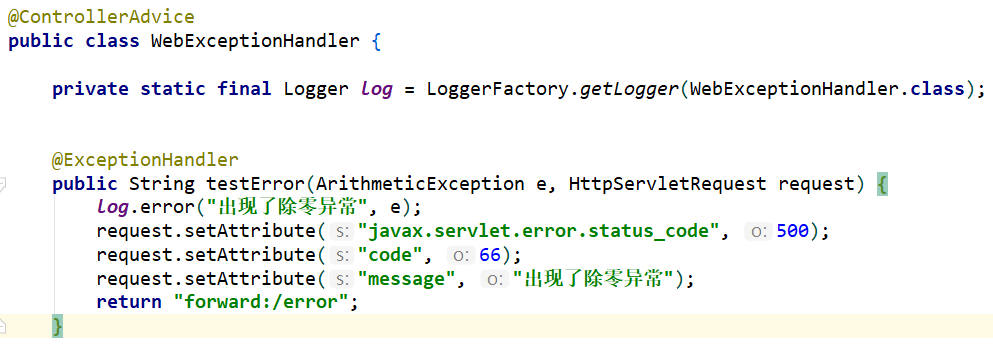 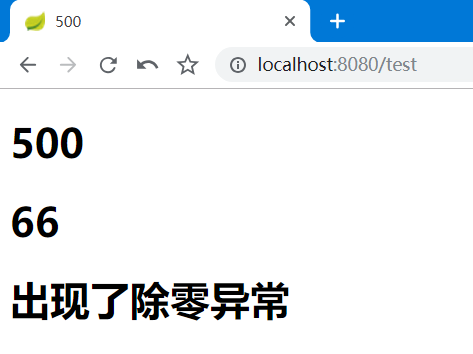 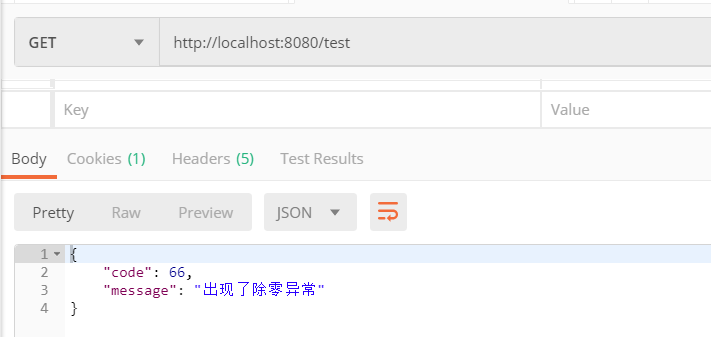 ## 前端 error 处理 现在使用了 HTTP 状态码, 所以 Ajax 请求出现错误后, 需要在每个 Ajax 请求方法中都写 `error: function() {}` 方法, 甚至麻烦. 好在 jQuery 为我们提供了全局处理 Ajax 的 error 结果的方法 [ajaxError()](http://www.w3school.com.cn/jquery/ajax_ajaxerror.asp) : ```javascript $(document).ajaxError(function(event, response){ console.log("错误响应状态码: ",response.status); console.log("错误响应结果: ",response.responseJSON); alert("An error occurred!"); }); ``` ## 结语 回顾一下讲到的这些内容: 1. 理解 `SpringBoot` 默认提供的 `BasicErrorController` 2. 自定义 HTTP 错误状态码, (通过 request 域的 `javax.servlet.error.status_code` 参数) 3. 自定义错误信息, (将我们自定义的错误信息放到 request 域中, 并重写 `DefaultErrorAttributes` 的 `getErrorAttributes` 方法, 从 request 域中获取这些信息). 4. 自定义错误页面, (根据 SpringBoot 查找错误页面的逻辑来自定义错误页面: `/error/500.html`, `/error/400.html`, `/error.html`) > 可以自己根据文章一步一步走一遍, 或者看我写好的演示项目先看看效果, 总是动手实践, 而不是收藏文章并封存。 > 演示项目地址: [https://github.com/zhaojun1998/exception-handler-demo](https://github.com/zhaojun1998/exception-handler-demo) 最后修改:2022 年 05 月 02 日 © 允许规范转载 打赏 赞赏作者 支付宝微信 赞 如果觉得我的文章对你有用,请我喝杯咖啡吧。